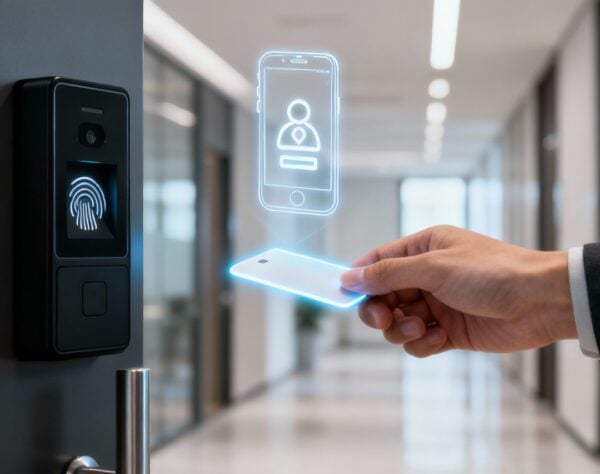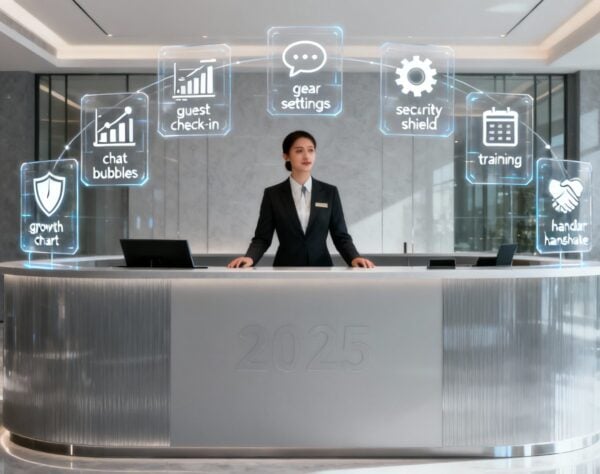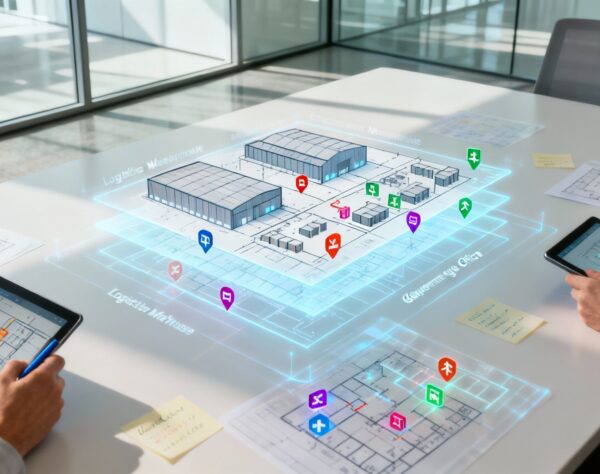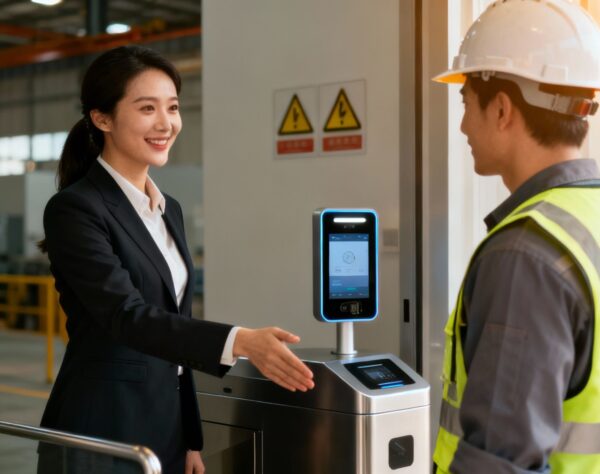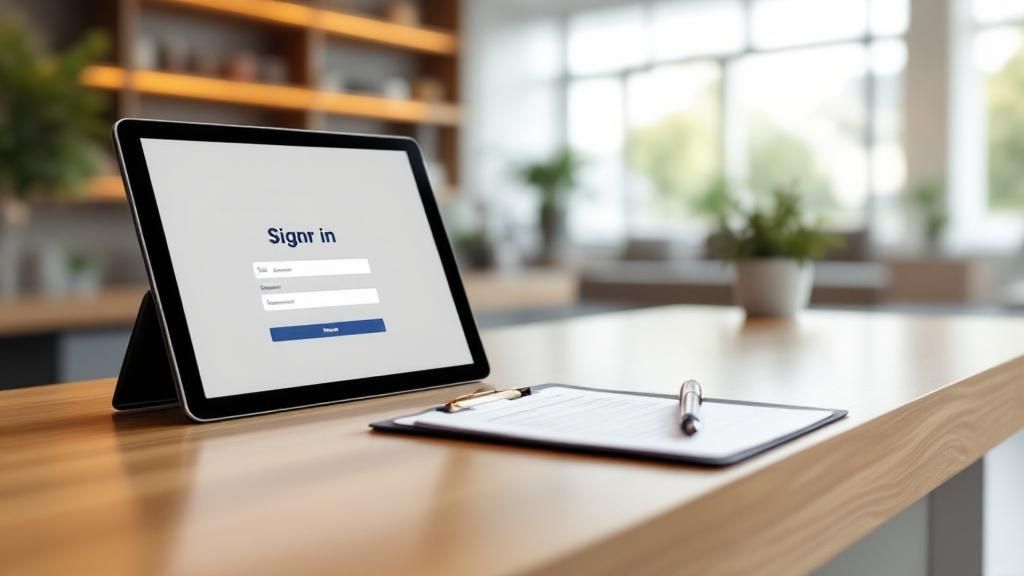
Your Guide to a Modern Visitors Signing In Sheet
A visitors signing in sheet is more than a list of names; it's the first interaction a guest has with your business. It's a critical tool for security, shaping their perception of your brand from the moment they arrive.
The choice between a paper logbook and a modern digital system reveals your company’s commitment to professionalism, security, and efficiency.
What a Visitors Signing In Sheet Reveals About Your Business

The clipboard at your front desk says more about your organisation than you think. While its primary function is to track who comes and goes, the sign-in process is a direct reflection of your company's values and operational standards.
A messy, hard-to-read paper sheet can signal disorganisation and a casual approach to security. Conversely, a streamlined digital experience communicates competence and a serious commitment to safety and data privacy.
Shifting from Logbook to Strategic Tool
The modern visitors signing in sheet has evolved from simple record-keeping into a strategic asset. An effective system isn’t just about logging names; it’s about creating a secure, efficient, and welcoming environment from the moment someone walks through your door.
This shift is crucial for any business that values its reputation and security. A paper log is imprecise and insecure. Important details can be illegible, and sensitive personal information is left exposed for anyone to see.
A study revealed that a staggering 88% of businesses fail to properly protect their paper documents containing sensitive information. This makes unsecured sign-in sheets a significant liability and highlights the urgent need for a more secure approach.
The Power of a First Impression
A digital visitor management system provides accuracy, real-time data, and intelligent insights. It transforms the visitor experience from a chore into a positive brand interaction. Consider the immediate benefits of this modern approach:
- Enhanced Professionalism: A sleek digital check-in creates a polished, modern first impression, showing visitors your business is forward-thinking.
- Improved Security: Digital systems provide a confidential and accurate log of everyone on-site, which is indispensable during an emergency. You can learn more about the importance of keeping an accurate visitors log in our detailed guide.
- Increased Efficiency: Automating the sign-in process frees up front-desk staff from manual data entry. This allows them to focus on higher-value tasks, like providing a genuinely warm welcome to guests.
Rethinking your sign-in process is a strategic business decision that strengthens security, boosts efficiency, and ensures every visitor’s first impression is a great one.
The Hidden Risks of Using Paper Visitor Logs
A paper-based visitors signing in sheet may seem familiar, but it's often a major liability hiding in plain sight. This outdated method introduces serious risks to your people, data, and reputation.
The most glaring problem is the lack of privacy. Every visitor's personal information—name, company, and host—is exposed on an open sheet. This public display of data is a massive security flaw and can be a direct violation of data protection principles. One study found that 88% of organisations don't adequately protect their sensitive paper documents, making an open sign-in sheet a prime example of this vulnerability.
Compromised Data and Compliance Failures
In an age of data privacy, a paper logbook is a compliance nightmare. Illegible handwriting leads to inaccurate records, making it impossible to know who was on-site at any given time. This not only weakens security but also creates significant legal risks if an incident occurs.
A paper visitors signing in sheet cannot keep up with modern data protection standards. For instance, finding and redacting a visitor's entry from a stack of old logbooks to comply with a data removal request is impractical, if not impossible.
A core business responsibility is safeguarding personal information. When visitor details are visible on a reception desk, you fail to protect their privacy and create a record that can be easily photographed or stolen, leading to potential data breaches.
This infographic highlights the immediate benefits of moving away from high-risk paper systems.
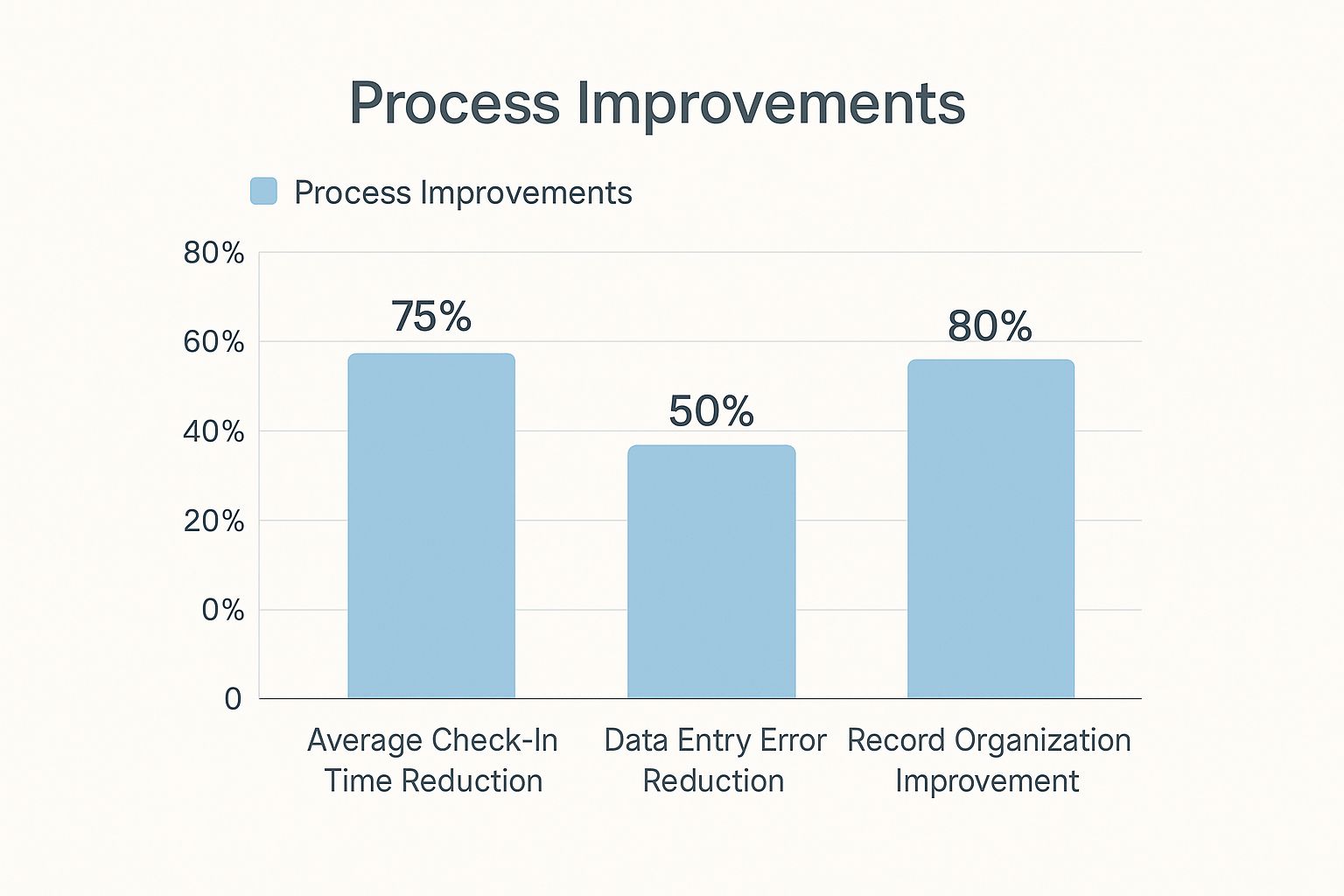
The numbers show that going digital delivers measurable improvements in efficiency, accuracy, and organisation, directly addressing the risks of paper logs.
A Poor First Impression and Inefficient Experience
Beyond security issues, paper logs create a frustrating and unprofessional experience. Queues at the front desk, the search for a working pen, and the awkwardness of a crowded clipboard all contribute to a negative first impression.
This clumsy process suggests your operations may be equally outdated. It undermines a professional welcome and can leave clients feeling undervalued before their meeting even begins.
Critical Safety and Security Gaps
The most severe risk of a paper visitors signing in sheet emerges during an emergency. An accurate, real-time list of every person on-site is non-negotiable for an evacuation. Paper logs are often incomplete, inaccurate, or inaccessible when needed most.
First responders rely on this data to ensure everyone is accounted for. An illegible or missing entry could have dire consequences. This is critical for managing Australian workplaces, which record an average of 743,210 short-term visitors each month. The need for accurate records was amplified post-pandemic, making dependable visitor registration essential. You can explore these trends with visitor data from the Australian Bureau of Statistics.
The table below breaks down the risk profile between old and new methods.
Paper Logbook vs Digital System A Risk Comparison
| Area of Concern | Paper Visitors Signing In Sheet (High Risk) | Digital Visitor Management System (Low Risk) |
|---|---|---|
| Data Privacy | Personal details are exposed for all to see. Easy to photograph or steal. | Visitor data is encrypted and stored securely. Only authorised personnel can access it. |
| Record Accuracy | Illegible handwriting and missed entries are common, creating an unreliable record. | Data is typed and verified, ensuring clear, accurate, and complete records every time. |
| Emergency Response | Logbook can be lost, damaged, or inaccessible, leaving first responders in the dark. | A real-time digital list of everyone on-site is available instantly on any device. |
| Compliance | Nearly impossible to comply with data removal requests or modern privacy regulations. | Easily manage and delete visitor data to meet compliance standards like GDPR or APP. |
| First Impression | Creates queues and a clunky, outdated check-in experience for guests. | Offers a smooth, professional, and quick sign-in that reflects a modern business. |
By sticking with paper, you are accepting a level of risk that modern alternatives eliminate. Moving to a digital system is a fundamental commitment to safety, privacy, and professionalism.
How Digital Visitor Systems Enhance Your Business
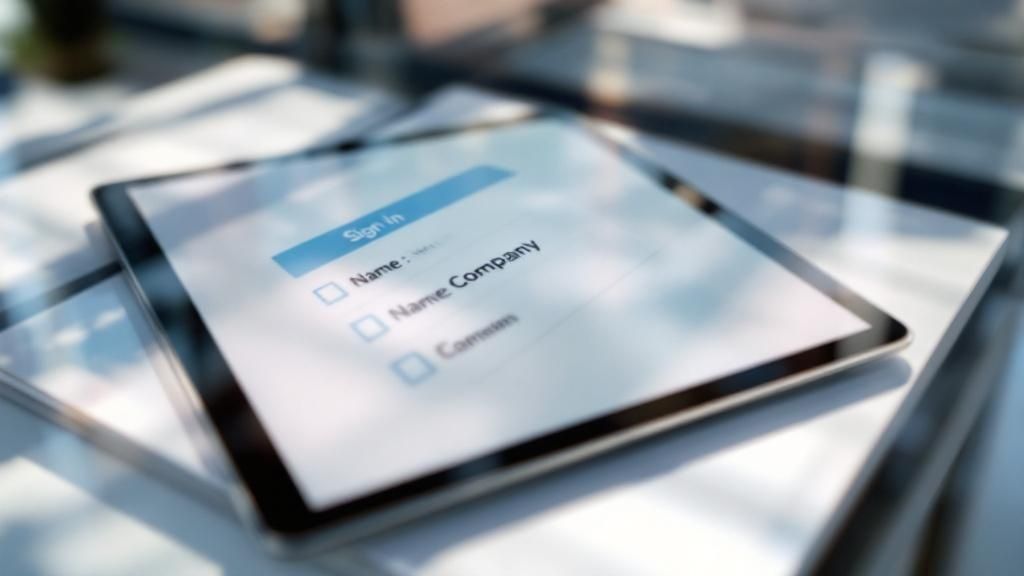
Switching from a paper logbook to a digital visitors signing in sheet is a strategic decision that delivers measurable results. The benefits go beyond features, unlocking stronger security, a sharper brand image, and smarter operations.
This shift transforms your front desk from a simple entry point into a dynamic hub of security and efficiency.
Instantly Strengthen Workplace Security
Going digital provides a significant leap in workplace security. A digital system gives you an accurate, live record of everyone on-site at any moment. This is a critical safety advantage.
During an emergency evacuation, knowing exactly who is in the building is vital. Studies show that businesses with automated systems can account for all personnel up to 60% faster than those using manual methods. In a crisis, those saved minutes are critical.
This security boost also extends to data protection. A paper sheet leaves names and company details exposed—a massive privacy risk.
A digital visitor management system is designed to protect visitor information. Data is stored securely with restricted access, preventing unauthorised viewing and helping you meet privacy regulations. This single change can eliminate one of the most common physical data breach risks.
Digitising your sign-in creates a secure, auditable trail of every person who enters your facility, protecting your people, property, and data.
Elevate Your Brand and Visitor Experience
Your reception area sets the tone for a visitor's entire experience. An outdated paper sign-in sheet feels disorganised. In contrast, a sleek, self-service digital check-in tells visitors you’re professional, efficient, and modern.
This positive first impression matters. Research shows a good customer experience can make people 86% more willing to do business with a company. A smooth, professional welcome reinforces your brand’s reputation as a competent, forward-thinking business. You can learn more by understanding what a visitor management system is and the value it adds.
Drive Significant Operational Efficiency
Automating your visitor sign-in process provides a serious operational boost. Manual sign-ins consume valuable time for admin staff. That time could be spent on more important work.
A digital system handles these routine tasks, freeing up your team to provide a warm welcome and manage more complex needs. Studies have found that automation can reduce administrative workloads by up to 40%, allowing teams to be more productive.
The efficiency gains are clear:
- Instant Host Notifications: Automated alerts via email or SMS reduce lobby wait times and keep schedules on track.
- Simplified Pre-registration: Visitors can pre-register online, completing forms before they arrive to make check-in instantaneous.
- Effortless Reporting: A visitor report for an audit is just a few clicks away, eliminating hours of searching through old logbooks.
When you choose a digital visitors signing in sheet, you’re investing in a more secure, professional, and efficient way of doing business, with benefits felt from your front desk to your bottom line.
Designing a Compliant and Effective Sign-In Process
An effective visitor signing in sheet captures the right information for the right reasons, balancing operations, security, and legal duties. The goal is to create a process that is functional, compliant, and respectful of visitor privacy.
This starts with determining the essential details you need to collect. A core principle of data privacy is minimisation—collecting only what is necessary for a specific, legitimate purpose.
Identifying Essential Data Fields
Every piece of information you request should have a clear purpose tied to security or operational efficiency. A well-designed process is lean, avoiding unnecessary hassle while meeting essential requirements.
Most organisations need these fundamentals:
- Full Name: The most basic identifier to know who is on your premises.
- Company: Provides context for the visit, especially for B2B meetings.
- Host's Name: Confirms the visitor is expected and ensures the right staff member is notified.
- Time In and Time Out: These timestamps are vital for creating a real-time emergency list and a historical record for security audits.
For businesses still using paper, options like carbonless visitor log forms create instant duplicates for your records, ensuring a backup is always available.
Navigating Critical Legal and Privacy Considerations
A compliant sign-in process must be transparent about data privacy. Your front desk is a key checkpoint for compliance with data protection laws.
Displaying a clear privacy statement during sign-in is non-negotiable. This statement should explain what data you're collecting, why you need it, how long you'll store it, and who can access it. Gaining explicit consent is a cornerstone of modern data privacy law.
A core principle of data protection is ensuring the "integrity and confidentiality" of personal information. Your sign-in process must have safeguards to prevent unauthorised access, whether it’s a secure digital database or a system that prevents new visitors from seeing previous entries.
This commitment to privacy builds trust and sends a clear message that you value their security. You can learn more about meeting these standards by reading about maintaining compliance in the workplace.
To put this in perspective, the Australian Bureau of Statistics samples over 30,000 international visitor interviews each year at airports—a process that begins with a form of sign-in. This large-scale data collection highlights why structured and compliant processes are so important from the first interaction.
A thoughtfully designed sign-in process is a strategic asset, reinforcing your commitment to security, efficiency, and respect for personal data.
Transitioning to a Digital Visitor Management System
Making the leap from a paper visitors signing in sheet to a digital system is a game-changing move. It's an upgrade to how you keep your site safe and welcome your guests. With proper planning, the switch is straightforward, and the benefits are immediate.
Focusing on long-term wins—like tighter security and a smoother front desk—makes it easy to see why the old clipboard is no longer sufficient.
Assess Your Security and Operational Needs
Before choosing a system, get a clear picture of what you need. A high-security manufacturing plant has different needs than a corporate office.
Start by asking a few key questions:
- What are our biggest security challenges?
- How much time does our front-desk team spend managing visitors?
- What kind of first impression do we want to make?
- Are we meeting our data privacy obligations?
Your answers will create a "must-have" checklist. For example, if site safety is your top priority, a system that generates instant emergency evacuation lists is essential. One study found that businesses with automated systems could account for everyone on-site up to 60% faster during a crisis.
Plan a Phased and Strategic Implementation
Once your goals are clear, map out a smooth rollout. A phased approach is best, giving your team time to adapt and allowing you to resolve any issues before a site-wide launch.
A pilot program is a great way to start. Test it at a single entry point or within one department. This provides invaluable feedback and helps build staff confidence. It’s the perfect time to gather insights and tweak the workflow if needed.
This approach also addresses a major hurdle: staff training.
Effective training is the bridge between a powerful tool and its successful adoption. A gradual rollout allows for focused, hands-on training, ensuring your team feels comfortable and empowered by the new process instead of overwhelmed.
Train Your Staff for a Seamless Switch
Your reception staff are on the front lines, so their buy-in is critical. Training should highlight how the new system makes their jobs easier by reducing admin load and automating tasks, freeing them to focus on giving visitors a great experience.
When your team understands the "why" behind the switch—enhanced security and a more effective front desk—they will become advocates for the new system. This ensures every guest has a positive experience. For more tips, check out our guide on how to move away from sign-in books with a visitor sign-in app.
The importance of accurate visitor tracking is a national issue. In July 2025, Australia saw approximately 743,210 short-term visitor arrivals, a 12.8% increase from the previous year. This large-scale data collection, starting with arrival cards that function like a massive visitors signing in sheet, highlights the criticality of efficient systems. You can see more on these trends in the latest overseas arrivals data.
By following a clear plan—assessing needs, planning a careful rollout, and training your team—you can confidently switch to a digital solution that delivers powerful returns.
Common Questions About Visitor Sign-In Sheets
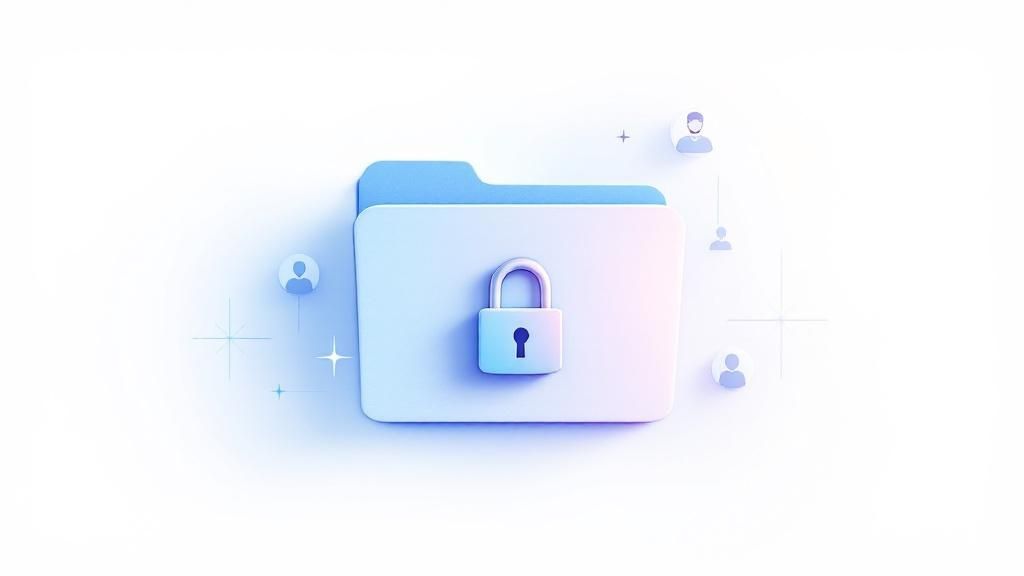
As you refine your visitor process, questions will arise. Whether you're replacing an old paper visitors signing in sheet or fine-tuning a digital system, getting the details right is key to creating a secure and professional process.
This section answers common questions to help you build a visitor experience that reflects the quality of your organisation.
How Long Should We Keep Visitor Records?
This question involves both data security and legal compliance. The ideal retention period depends on your industry regulations and internal security policies.
For most businesses, keeping records for three to six months is a good benchmark. This provides a sufficient window to investigate security incidents without holding personal data indefinitely.
However, some sectors have stricter rules. High-security sites may need to keep records for a year or more. The key is to create a clear, documented policy and automate it.
A key benefit of a digital visitor management system is its ability to automatically purge old data. This feature keeps you aligned with your data retention policy without manual intervention, reducing the risk of human error and ensuring compliance with data minimisation principles.
An automated approach ensures you aren't holding sensitive information longer than necessary, a core principle of modern data privacy laws.
Can We Ask Visitors to Sign a Non-Disclosure Agreement?
Yes, and integrating a non-disclosure agreement (NDA) into your sign-in process is an excellent way to protect your intellectual property. This is especially important for businesses where visitors might be exposed to sensitive information.
A digital visitors signing in sheet makes this seamless. The NDA appears as a required step on the screen during check-in, allowing visitors to sign directly on the tablet.
This method offers several benefits:
- Improved Efficiency: It eliminates the need for reception staff to manage paper NDAs, saving time and administrative effort.
- Centralised Record-Keeping: Every signed NDA is stored digitally with the visitor's record, creating a secure and searchable audit trail.
- Enhanced Compliance: It ensures every visitor agrees to your terms before entering your facility, leaving no room for error.
Integrating NDAs this way strengthens your legal position and demonstrates a professional, security-conscious approach to every guest.
What Is the Best Way to Handle Large Groups or Events?
Managing a large group with a manual sign-in sheet creates long queues and a poor first impression. A digital system handles this professionally through pre-registration.
You can send a registration link to all attendees before they arrive. They can fill in their details, sign any required documents, and receive a unique QR code for a fast check-in.
The result is a superior visitor experience. Instead of a bottleneck at the front desk, guests simply scan their code and enter in seconds. This efficiency reflects well on your organisation and starts your event on a positive note.
Ready to replace your outdated visitors signing in sheet with a secure, professional, and efficient solution? Discover how VisitUs can transform your front desk, enhance your security, and create an exceptional first impression for every guest. Learn more about VisitUs and book a demo today.


